Take on the forces of He-Who-Must-Not-Be-Named in this cooperative deck-building game, working your way through 7 “years” of Harry’s life at Hogwarts.
At a glance
Harry Potter: Hogwarts Battle is a cooperative game for 2 to 4 players, ages 11 and up, and takes about an hour to play. The game retails for $49.95 and made its debut at Gen Con 2016, and is available now. I’ve been playing through it with my wife and two daughters (ages 10 and 13), and I think the game could be played by kids slightly younger, although it does follow the Harry Potter story and so it gets darker as you get to the later books/films. It was invented and licensed by Forrest-Pruzan Creative, and designed and developed by USAopoly.
Spoiler Alert: Just in case you haven’t read the books or seen the movies, I should note that the game does include plot points from the story, so if you really don’t want to know, say, the bad guy at the end of Book 1, you should probably avoid this review. Otherwise, I’ve tried to keep spoilers about the game itself to a minimum.
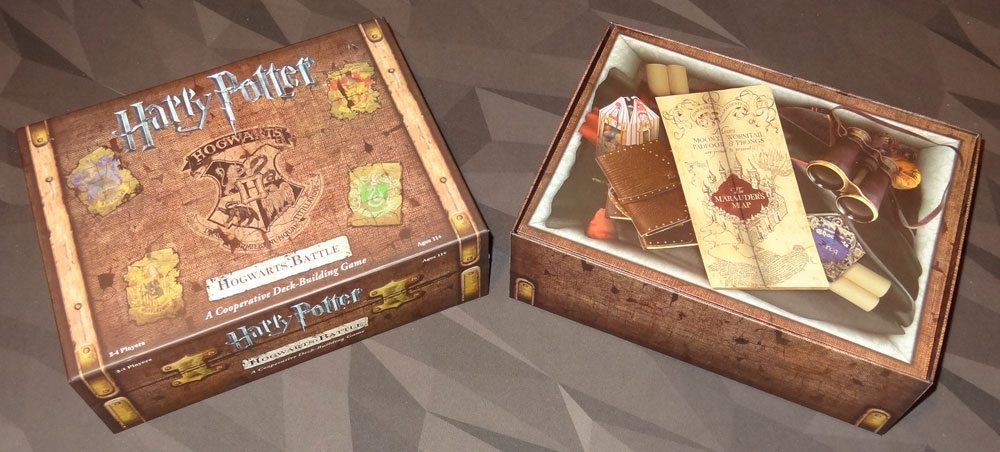
Components
Normally, I would just list all the components here, but Harry Potter: Hogwarts Battle is a little unusual. There are seven small boxes inside the box, and you open them up as you play the game and follow Harry and his friends through the seven years at Hogwarts. It’s not a legacy-style game, exactly, because nothing is permanently changed—you can reset to whichever game you want, and your Game 2 doesn’t affect how Game 3 is played. However, since you might want to preserve the surprise of what’s in the boxes, I’ve moved some of the components to a second page of this review. The back cover of the rulebook does have a component count, so if you look at that you will get a minor spoiler for what’s inside some of the boxes, and marketing photos of the game do show some of these components, so it’s not a huge secret either way.
Right from the start, though, you can tell that there’s been some care put into the look of the game: the box is made to look like a beat-up trunk, and when you remove the lid, the back of the folded game board looks like the inside of the trunk, which is a lot of fun. The box itself is a nice, thick cardboard. The game is done using photos and artwork from the movie series, so if you’re a fan of the films, you’ll enjoy seeing the actors as the characters. If you’re a book purist or you weren’t happy with some of the casting decisions, well, you may just have to put up with people not looking exactly the way you pictured them in your mind.
The four characters that you’ll get to play are Harry Potter, Hermione Granger, Ron Weasley, and Neville Longbottom.
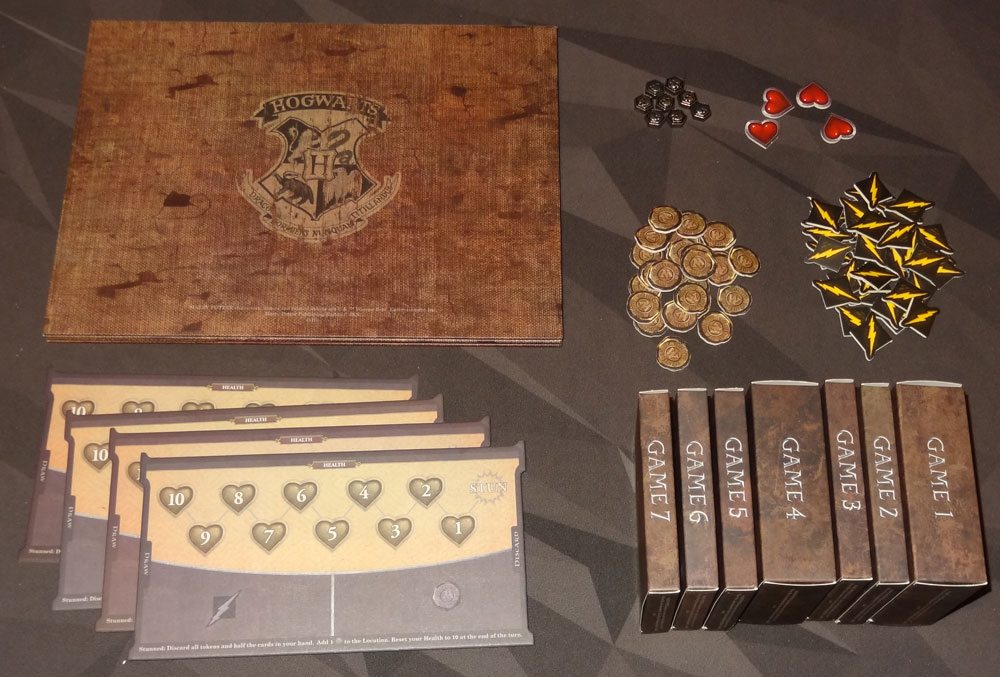
What I can tell you without spoiling anything is that you get:
- 1 game board
- 4 Health Tracker boards
- 8 Villain Control tokens
- 35 Attack tokens
- 25 Influence tokens
- 4 Health tokens
The Health, Attack, and Influence are all cardboard tokens—they’re nice and thick, but nothing too exciting. The Influence tokens are made to look like coins, with the Ministry of Magic logo on them.
The player boards have a large health track, and areas to store attack and influence tokens until spent. The left and right sides are notched a little so that your deck and discard pile nestle into the board, and the top is notched so that your turn order summary card and character card fit along the top. At the bottom is some reminder text about what to do if you’re stunned. It’s functional, but not especially exciting.
The game board itself is also not really exciting—it’s made to look like parchment, with borders for certain areas of the cards, and then faded-out card backs to show you where various decks or tokens are placed. I do wish the board had a little more flavor to it—I think it’s supposed to recall the Marauder’s Map, but there isn’t really enough decoration on it, and it ends up looking more like a big blank piece of parchment. With as much detail was put into the board’s back, it would be nice to see some more on the front, too.
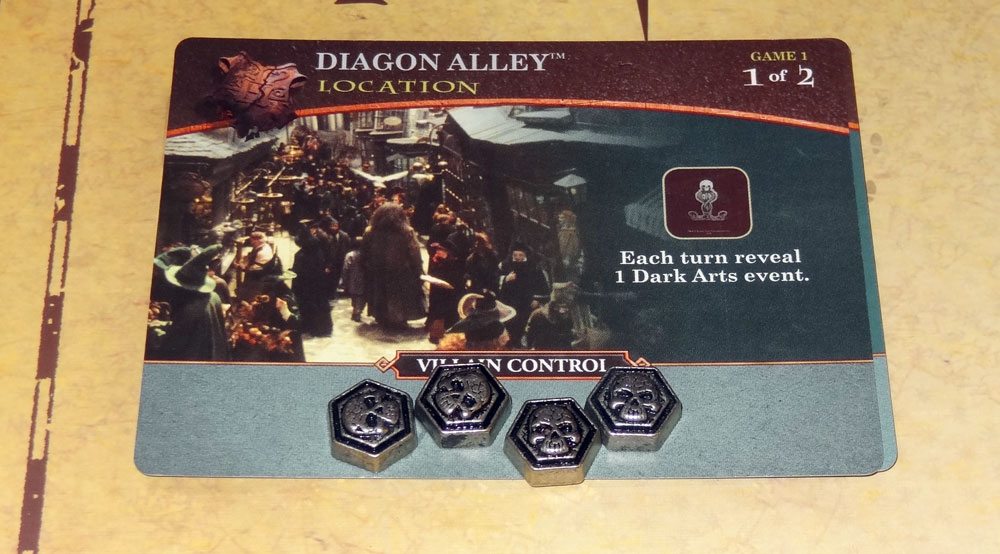
The Villain Control tokens are really great—they’re actual metal with some black antiquing, with little skulls on them. They’re the best component in the game, and although everything else is fine, these metal tokens make everything else seem less spectacular in comparison.
And there are, of course, a number of cards—I will have to tell you about these in order to explain the game, but it’s not much of a spoiler to tell you that this deck-building game includes cards. There are various cards: Dark Arts cards, Location cards, Villain cards, Hero cards, and Hogwarts cards (which are the ones used in the actual deck-building).
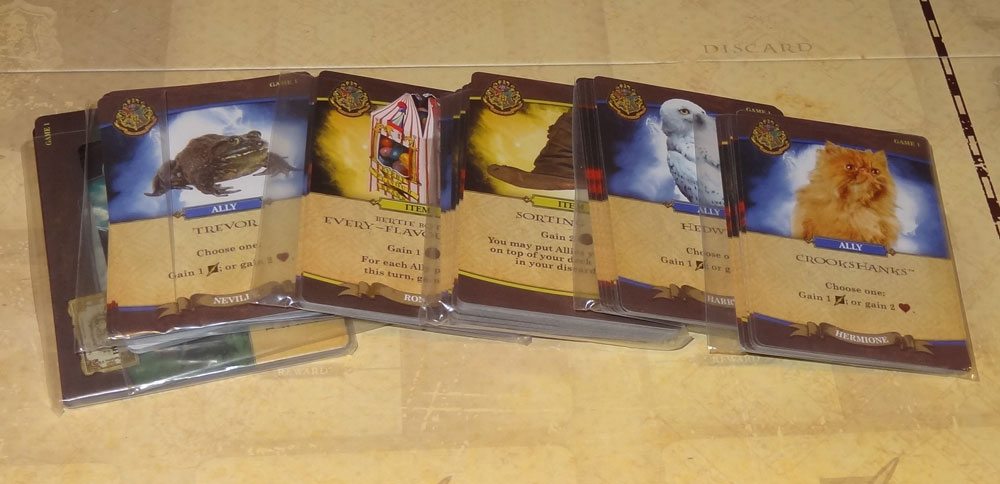
Each box includes more cards for the next game, though the first box includes more cards to get the game started, as well as card dividers for the main box. The Game 4 box is larger than the others, and includes something more—probably something that fits into the extra space in the main box’s plastic insert. The cards come in loose plastic sleeves, helping to divide them into the various types so you can get going quickly, without having to open shrink wrap and sort them—that’s a nice touch. The cards are generally fairly self-explanatory, with clear text about what each one does and what type of card it is.

The two large areas on the right side of the box are designed to hold all of the cards for the game—but at the beginning, you won’t have enough cards to fill them, so things may slide around a little. Fortunately, the well is divided about 2/3 of the way through, so that you can put the whole set of cards in one well, then the other, and then split across the two wells as you add more cards from the boxes.
One fun bit: the spell cards show the gesture accompanying the spell, so if your kids (or you) have wands and want to add spells to your repertoire, you could study these cards and practice the spells.
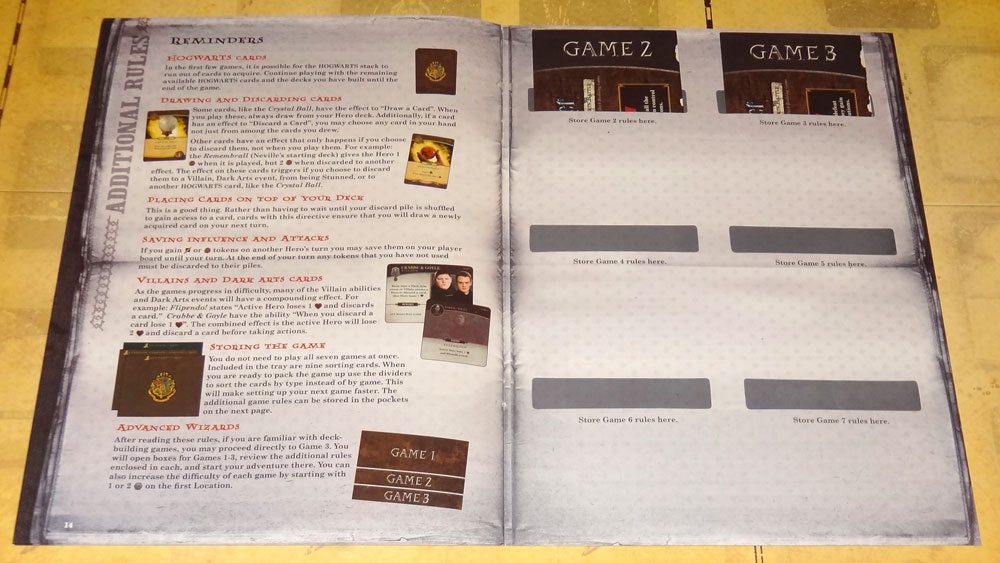
Starting with Game 2, there’s also a small rules sheet included in each box, so that you can see whether there are any updates or rule changes from the previous games. The back page of the rulebook has six pockets for you to store the rulesheets from Game 2 through Game 7, so that it’s easy to refer to them once you’ve opened everything up.

One complaint I’ve seen elsewhere is that the card backs are not totally consistent, and you can see from the photo above that this is the case. It’s something that has happened with other games, too (notably, Pathfinder Adventure Card Game), and it does mean that you can distinguish cards from each other somewhat by looking at the backs. However, unlike Pathfinder, these cards are generally only in your decks or face-up in the market, so you’re never choosing a card by looking at its back, and I didn’t find it to have a significant effect on gameplay.
How to Play
Harry Potter: Hogwarts Battle is a cooperative game, and all the players are working together to defeat the villains before the villains take control of all the locations.
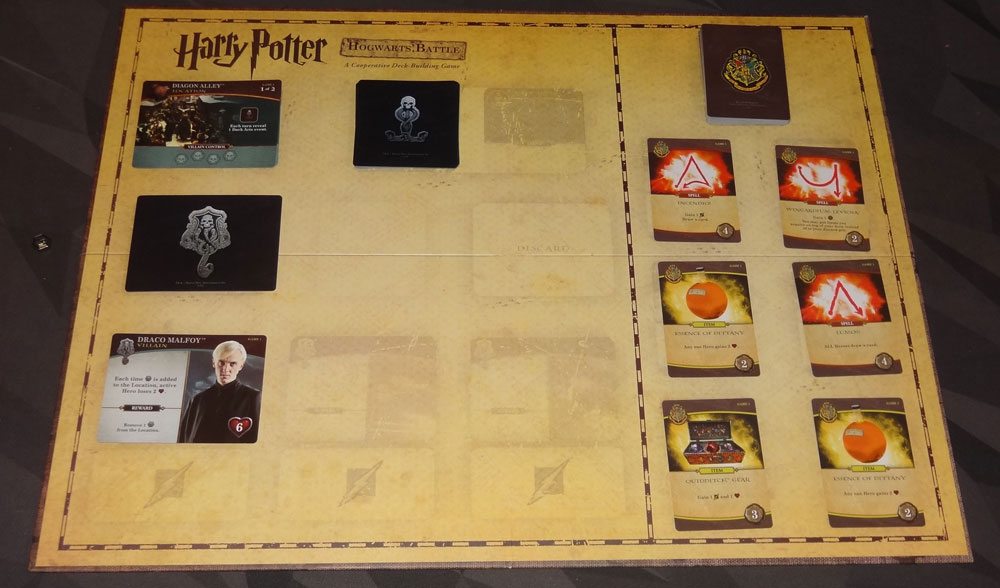
To set up, place the various cards onto the board:
- Location cards: Use the ones specific to the game you are playing, and have a specific order.
- Villain cards: Shuffle all the villains so far into one deck, and reveal some below. (In Game 1, you only reveal one at a time, but eventually you may reveal up to three at once.)
- Dark Arts cards: Shuffle all of them so far into one deck and place face-down on the board.
- Hogwarts cards: Shuffle all of them so far, and reveal the top six in the market area.
In addition, each player takes a player board and a health token (set at 10 health), along with the character card and that character’s starting deck of cards.
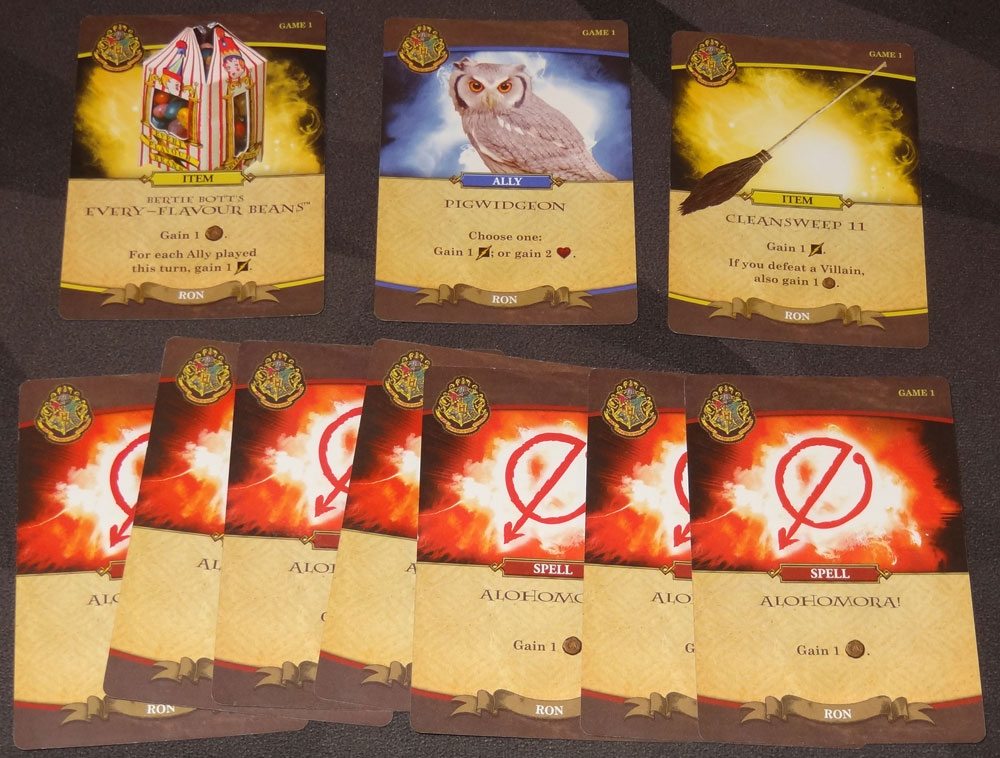
Each time you play, you will start with just your 10 starting cards (as the rules explain, maybe you should have practiced those spells a bit more over summer break so you didn’t forget them all). Each player has 7 Alohomora spells, plus one Ally (their animals) and two items. The Alohomora is a basic spell that gives you one influence for buying more cards, and the others have a mix of abilities, so that each player has a slightly different focus.

As you progress, you will also gain new character cards that show the character a little older, but also unlock new abilities and differentiate the characters even more. There aren’t new character cards in each game box, so you’ll just use the most recent available one when you play.
Each player shuffles their starting cards, and draws 5 cards for their initial hand.
Harry Potter: Hogwarts Battle is a deck-building game, so each player has their own deck of cards and their own discard pile. You will acquire new cards, which typically go into your discard pile, and if your deck ever runs out, you shuffle your own discard pile to form a new deck. You start with fairly basic cards, and over the course of the game you’ll add in more powerful cards. Unlike some deck-building games, there isn’t any way to “trash” or remove cards from your deck.
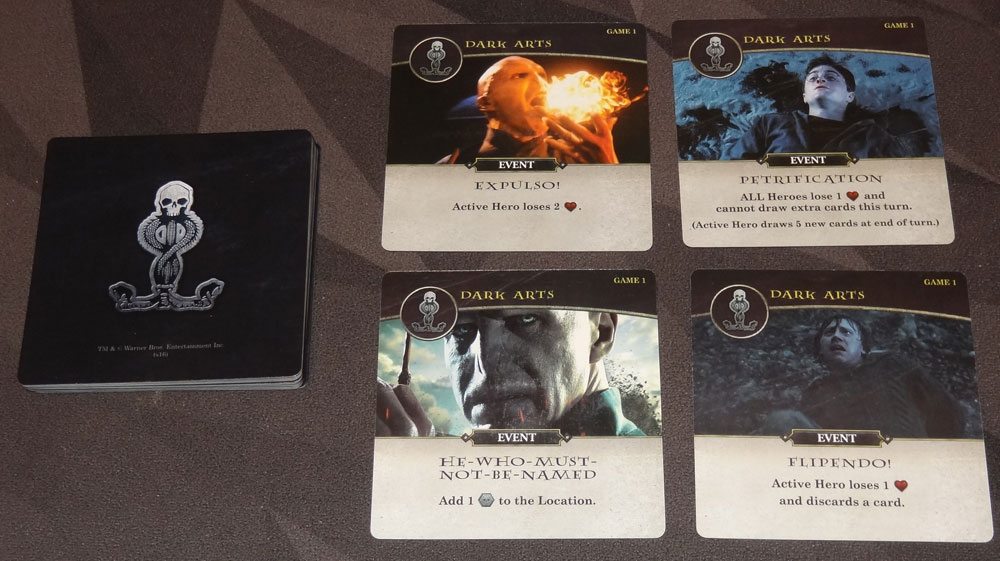
On each turn, the first thing you do is draw Dark Arts cards—the current Location tells you how many to flip. Each one does something nasty to you, or to everyone. You might lose health, discard cards, add villain control to the Location, and so on.
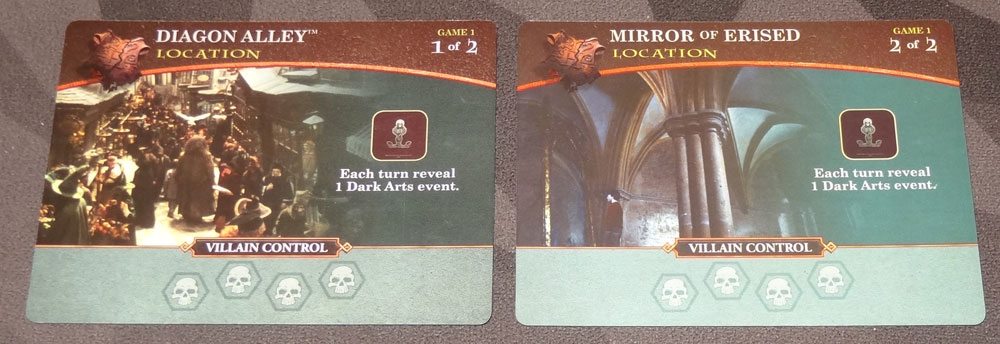
If a Location is ever filled up with control tokens, that Location has fallen and is discarded, revealing the next Location (which may tell you to draw more Dark Arts cards at the beginning of your turn). If you ever lose all of the available Locations, you lose the games.
If your health ever runs out and you reach the “Stun” spot on your health track, you’ve been stunned. You must discard half (rounded down) of your cards, add 1 villain control to the Location, and then you may continue your turn. At the end of your turn, you reset to 10 health and are no longer stunned.

Then, you activate all of the displayed villains. Some of them have qualifications—for instance, Draco Malfoy only affects you when villain control is added to the Location, but Quirrell costs you 1 health when it’s your turn, no matter what.
Then, it’s your turn. You play any number of your cards, collecting influence, attack, and health on your board. Influence may be spent to purchase cards from the market, which are then put into your discard pile. Attack can be placed on the board below any of the displayed villains.If there is ever enough attack on a villain to match its health value, the villain has been defeated. Get the reward shown on the villain. You can’t save cards, attack, or influence on your board for your next turn, so at the end of your turn everything you still have is discarded—spend it while you have it!
At the end of your turn, you replace any villains that were defeated and any Hogwarts cards that were purchased.
If you’ve defeated all the villains, you win!
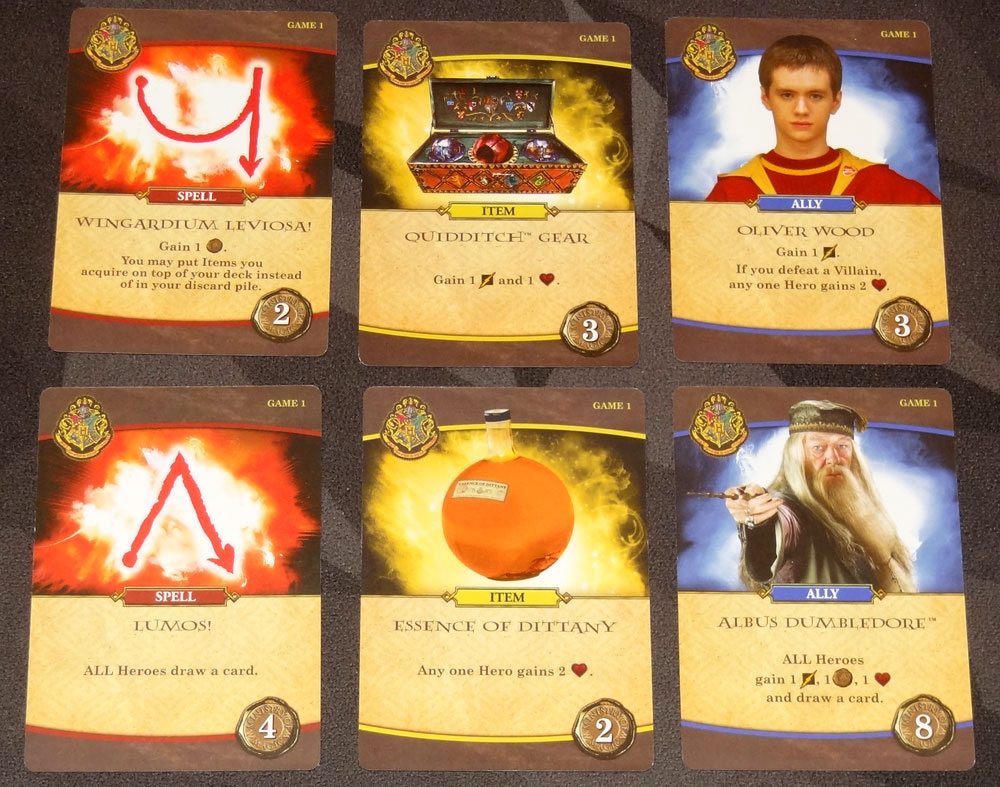
The Verdict
Harry Potter: Hogwarts Battle is an interesting hybrid: the included game boxes remind me of legacy-style games like Risk: Legacy and Pandemic: Legacy since you’re intended to play through them in a particular order, and getting to open up a box and see what’s inside lets you extend that “opening something new” feeling beyond the initial unboxing. Unlike a legacy game, though, nothing is destroyed or permanently altered—you don’t tear up cards, or put stickers on boards, or mark things up. If you’ve played through the whole thing and want to reset to Game 4, you can do so just by sorting out the cards (they’re marked at the top of each card) and putting Games 5–7 back into their boxes. In that sense, it’s perhaps closer to the Legendary: Encounters series of games, where you can play a number of different scenarios, just based on which cards you decide to include.
For Harry Potter fans, though, it is a lot of fun to feel like you’re following the progress of the books (or, really, the movies) as you open up each box and add new allies, more powerful spells, and new villains to the game. The one thing that is a little strange, thematically, is that you do shuffle in all of the old villains, so Quirrell—even though he’s only present in the first book—will show up in later games, to be defeated again and again. In each new game, you get a new set of Location cards that replace the old ones, but the new Dark Arts, Villain, and Hogwarts cards are shuffled in with the existing ones. So that means you have more Villains to fight each time, but you may also have Locations that allow for more villain control tokens before being overrun, and you also have access to new cards from the Hogwarts market area.
The difficulty level of the game is not too high. Most cooperative games are designed so that you have a fairly low success rate, because it can be boring if you win every time you play. I’ve been playing through Hogwarts Battle with my wife and two older daughters, and so far we’ve won every time (up through Game 3)—but each time we do get to see some new cards, so that does add some interest even though we haven’t suffered a loss. I did find that in Game 3, even though we got stunned many more times because we ran out of health, we never lost any Locations, and it felt that the mix of Dark Arts cards and Villain cards meant that the effects that added control were somewhat diluted. (And we did happen to get pretty lucky in the case of the one villain who can potentially add more control, so the game could have played out differently.)

While we haven’t played through all 7 games yet, my family has been enjoying it and getting into character (though, of course, both of my daughters wanted to be Hermione). And I’m particularly pleased to find a game that my wife wants to play with us—the theme definitely helps, since she’s a big Harry Potter fan, but I think the intro-level rules complexity is also a factor.
It does seem that the game has been geared toward new players, making it as easy as possible for those who haven’t played deck-building games before to learn how to play. In fact, Games 1 and 2 are set up as introductory games, and the rules recommend that if you’re already familiar with deck-building games, you could just skip directly to Game 3… but who wants to skip part of the story? The other tweak is that you can start the game with 1 or 2 villain control tokens already on the Location, which would certainly advance the game a bit.
USAopoly and Forrest-Pruzan had to strike a fine balance: catering to fans of the books and films who weren’t hard-core gamers, and attracting gamers who might not be huge Harry Potter fans. (Though, let’s face it—probably this game will mostly be picked up by those who have at least some knowledge of and interest in Harry Potter.) I think they did a good job: the game was designed to be friendly for newer players, but it’s still a solid game. I think it’s going to be particularly enjoyable for fans of Harry Potter who want to experience the stories in a new form—but who aren’t interested in a dumbed-down kids’ game. For experienced deck-building players, Hogwarts Battle does not add a lot of new mechanics, though there are some features that I haven’t seen as much in other games. It’ll probably come down to whether or not you enjoy the theme.
So, for Harry Potter fans, I’d give this a big thumbs-up. Although there are some quirks with the theme (mostly having to do with things that carry over from game to game that were only in one of the books), overall Hogwarts Battle is a fun cooperative game with easy-to-learn mechanics designed for Potterphiles. If you’re not a fan of the series, it may be hit or miss—some of the theme will be lost on you, but the game mechanics are still pretty good.
You can learn more about Harry Potter: Hogwarts Battle at the USAopoly site, or order a copy here.
If you’d like to find out more about the other components from Game 4, click here for the next page.
Disclosure: I received a review copy of this game.
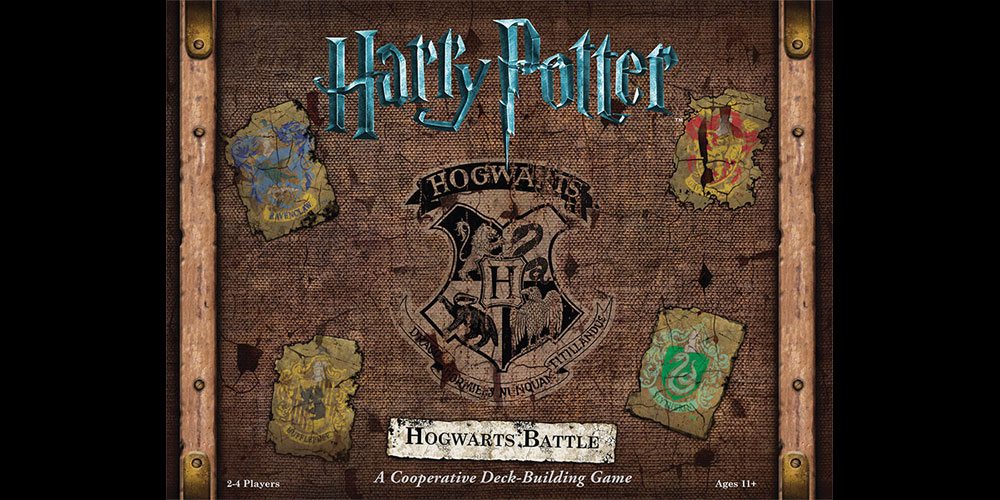



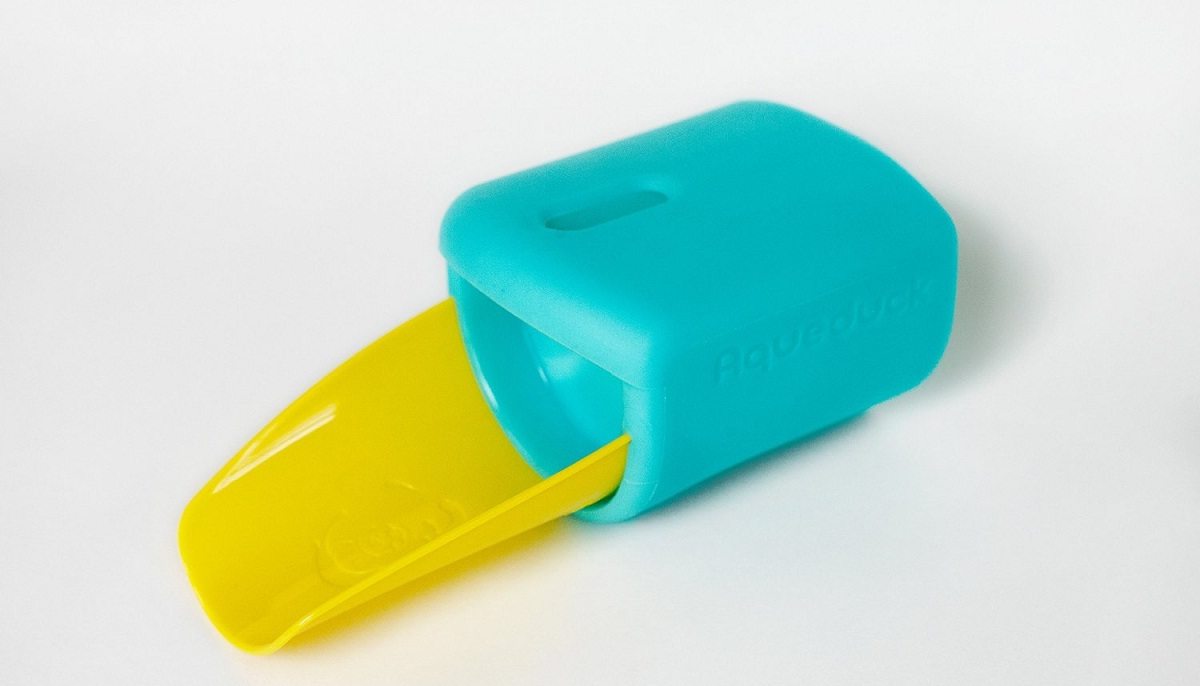
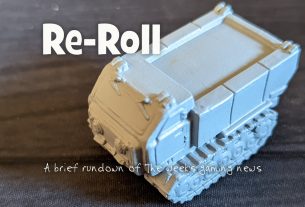
Have you played more since and have your opinions changed at all? I ask because I’ve played probably 20 games up through level 6 and starting around game 5 we started losing far more than winning- it’s not a bad thing at all- but it got a lot harder as we moved up. There seems to be a lot of “luck of the draw” with villains. You can get screwed right off the bat, or get harder ones later, once you’ve actually got a deck to play with. I’m an unabashed Potterhead, but I think I’d like this game even with a different theme. I’m just curious what your take is now!
Well, we’ve only played up through Book 4 so far—because we’re waiting on my middle daughter to finish reading the series. 🙂 She was never as much of a reader as her older sister, and stalled out after Book 4 a couple years ago. So we had to stop playing until she caught up, because I didn’t know what might be spoiled through the game, but we’ve also decided that we’re going to play through it as a family (instead of me skipping ahead with my game night friends).
I do see that it’s getting harder, though, simply because you have to get through the entire pile of villains every time, and we had some combinations of villains in Book 4 that were pretty nasty. But we’ve also had situations where a villain is very ineffective at the time it happens to come out, so I definitely see that luck of the draw plays into it. We do try to plan out which villain to go after first, and whether to pile all our attack in one place or spread it across all available villains.
I’ll be interested to see how it feels once we’re fighting three villains at a time!
Nice review. Just wanted to mention that I think there’s a typo in the 3rd paragraph of the Verdict section. “The new Dark Arts, Villain, and Location cards are shuffled in with the existing ones” — I think you mean Hogwarts rather than Location in this quote. If you add location cards in (rather than replacing the previous ones) each time you open a new Book, I think the game will become too easy.
Oops! You’re right—I’ll get that corrected!
Thank you!
I can’t find any information on how to use the Petrificus Totalis tokens. Does anyone have any tips?
Hi, Karen! It’s tied to the Petrificus Totalis spell, which will be mixed into the Hogwarts deck. You might flip through the deck to see it. Basically when you cast it, it shuts down one of the villains from using their power until your next turn, so you put the token onto the villain as a reminder.
When a Dark Arts event requires you to discard an ally or item, does it discard back into your pile, into the draw pile, or is it in the discard pile and out of the game? We can’t seem to find a clear answer in the instructions or online. Thanks for your help.
Hi! Any time you discard a card, it goes into your own private discard pile. It’s a typical rule for the deck-building style of game, but quite often the rulebooks assume that you’re already familiar with that gameplay and don’t spell everything out as clearly. They usually will use another term for removing a card from the game, like “trash” or “destroy”—I don’t think I’ve come across that particular effect in Hogwarts Battle, though.
If you get the dark arts card that says discard this item or lose 2 health, what if you dont have that specific item in your hand. Do you still lose 2 hearts?
My understanding is that if you have the item, you can choose, but if you don’t have the item, then you have to lose hearts.
My granddaughters and I are up to game 7. In game 5 Dolores Umbridge showed up with the ability, “Each time a Hero acquires a card with a value of 4 or more galleons, that Hero loses 1 heart.” We assumed that she was a “sleeper”… that she wasn’t effective until a later game, because there were no cards that had a value of 4 or more galleons. But having now reached game 7 there still are no cards with that value. Are we reading her action incorrectly? How are we supposed to interpret her ability?
Hi, Kit,
That’s the cost of acquiring cards from the Hogwarts deck, and there are cards even from Deck 1 that cost at least 4. For instance, the Lumos spell costs 4, and Dumbledore (who is present even from the first deck) costs 8. Hagrid also costs 4; the Nimbus 2001 from Game 2 costs 5. Any time any of those cards are acquired from the Hogwarts area, the hero who acquires it loses 1 heart.